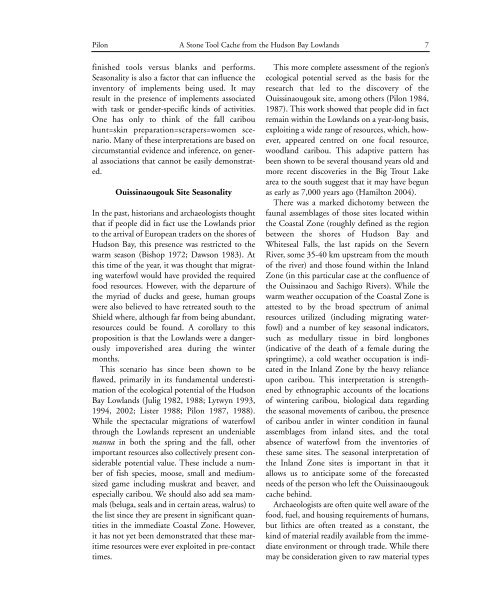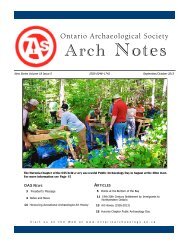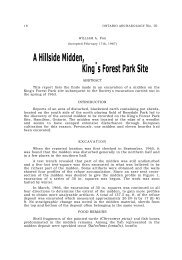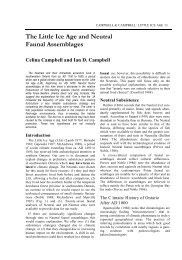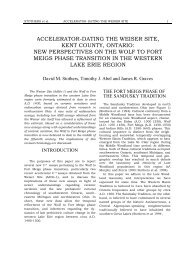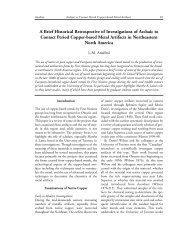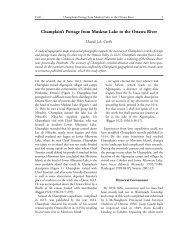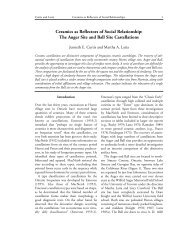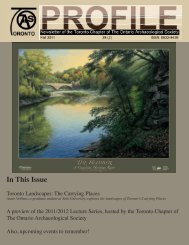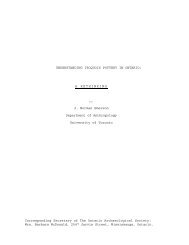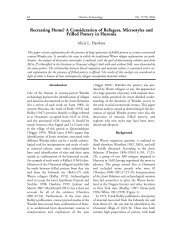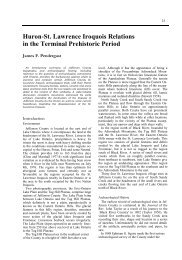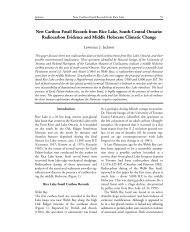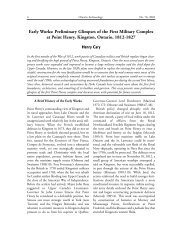oa 74 part 01 pilon layout - Ontario Archaeological Society
oa 74 part 01 pilon layout - Ontario Archaeological Society
oa 74 part 01 pilon layout - Ontario Archaeological Society
- No tags were found...
Create successful ePaper yourself
Turn your PDF publications into a flip-book with our unique Google optimized e-Paper software.
Pilon A Stone Tool Cache from the Hudson Bay Lowlands 7finished tools versus blanks and performs.Seasonality is also a factor that can influence theinventory of implements being used. It mayresult in the presence of implements associatedwith task or gender-specific kinds of activities.One has only to think of the fall caribouhunt=skin preparation=scrapers=women scenario.Many of these interpretations are based oncircumstantial evidence and inference, on generalassociations that cannot be easily demonstrated.Ouissinaougouk Site SeasonalityIn the past, historians and archaeologists thoughtthat if people did in fact use the Lowlands priorto the arrival of European traders on the shores ofHudson Bay, this presence was restricted to thewarm season (Bishop 1972; Dawson 1983). Atthis time of the year, it was thought that migratingwaterfowl would have provided the requiredfood resources. However, with the de<strong>part</strong>ure ofthe myriad of ducks and geese, human groupswere also believed to have retreated south to theShield where, although far from being abundant,resources could be found. A corollary to thisproposition is that the Lowlands were a dangerouslyimpoverished area during the wintermonths.This scenario has since been shown to beflawed, primarily in its fundamental underestimationof the ecological potential of the HudsonBay Lowlands (Julig 1982, 1988; Lytwyn 1993,1994, 2002; Lister 1988; Pilon 1987, 1988).While the spectacular migrations of waterfowlthrough the Lowlands represent an undeniablemanna in both the spring and the fall, otherimportant resources also collectively present considerablepotential value. These include a numberof fish species, moose, small and mediumsizedgame including muskrat and beaver, andespecially caribou. We should also add sea mammals(beluga, seals and in certain areas, walrus) tothe list since they are present in significant quantitiesin the immediate C<strong>oa</strong>stal Zone. However,it has not yet been demonstrated that these maritimeresources were ever exploited in pre-contacttimes.This more complete assessment of the region’secological potential served as the basis for theresearch that led to the discovery of theOuissinaougouk site, among others (Pilon 1984,1987). This work showed that people did in factremain within the Lowlands on a year-long basis,exploiting a wide range of resources, which, however,appeared centred on one focal resource,woodland caribou. This adaptive pattern hasbeen shown to be several thousand years old andmore recent discoveries in the Big Trout Lakearea to the south suggest that it may have begunas early as 7,000 years ago (Hamilton 2004).There was a marked dichotomy between thefaunal assemblages of those sites located withinthe C<strong>oa</strong>stal Zone (roughly defined as the regionbetween the shores of Hudson Bay andWhiteseal Falls, the last rapids on the SevernRiver, some 35-40 km upstream from the mouthof the river) and those found within the InlandZone (in this <strong>part</strong>icular case at the confluence ofthe Ouissinaou and Sachigo Rivers). While thewarm weather occupation of the C<strong>oa</strong>stal Zone isattested to by the br<strong>oa</strong>d spectrum of animalresources utilized (including migrating waterfowl)and a number of key seasonal indicators,such as medullary tissue in bird longbones(indicative of the death of a female during thespringtime), a cold weather occupation is indicatedin the Inland Zone by the heavy relianceupon caribou. This interpretation is strengthenedby ethnographic accounts of the locationsof wintering caribou, biological data regardingthe seasonal movements of caribou, the presenceof caribou antler in winter condition in faunalassemblages from inland sites, and the totalabsence of waterfowl from the inventories ofthese same sites. The seasonal interpretation ofthe Inland Zone sites is important in that itallows us to anticipate some of the forecastedneeds of the person who left the Ouissinaougoukcache behind.Archaeologists are often quite well aware of thefood, fuel, and housing requirements of humans,but lithics are often treated as a constant, thekind of material readily available from the immediateenvironment or through trade. While theremay be consideration given to raw material types


